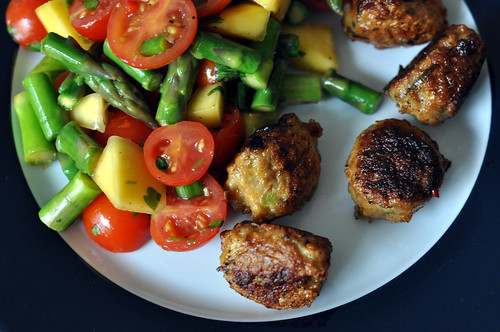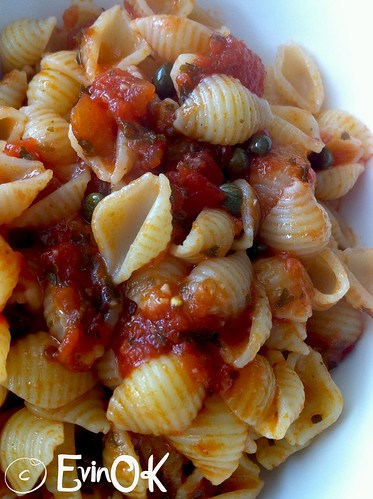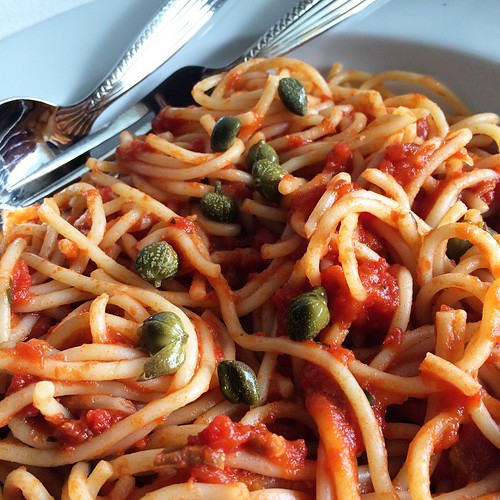Life is all about stopping to smell the flowers, right? What about taking time to stop and eat the flowers? This week, you can give it a chance by cooking with capers. These small flower buds come from a Mediterranean shrub and have been a staple in regional cuisine for thousands of years. These shrubs can also be found in parts of Africa, Asia, Italy, southern France, Spain, Turkey, Greece, and Morocco. Buds vary in size from delicate small ones (nonpareils) to large ones (not to be confused with caperberries which usually have seeds and a stem).
While closed, the caper shrub’s flower bud is hand picked then pickled to create the tangy flavors that are synonymous with the capers available jarred in grocery markets. They are packed in salt or brine to preserve the buds, making them a bit salty and deliciously tart. Customize your capers with Julia Child’s wise recommendation to replace half of the jar’s brine marinade with vermouth. This is also possible to add a little punch to green olives destined to be in martinis. Capers are an international affair. Their pickled nature makes them easy to transport worldwide so countries from the Mediterranean to the Arctic to the Panama Canal may incorporate capers into their cuisine.
This week, travel to Europe by enjoying Frikadellers. A few countries have variations of this recipe, using different meats and shapes to make it their own, but it is usually accepted as Danish in origin. For decades, my family has enjoyed this light and delicious meatball served with rice or roast potatoes. Pasta Puttanesca bring Italy to your table as the sweet scents of the sauce waft through the air. Surprisingly simple, the vegetarian sauce holds up to variations and reheating. Travel the world without leaving your kitchen with the charm of capers in international cuisine.

Frikadellers
1 lb ground turkey or veal
1/4 cup lemon juice
2 eggs
1/4 cup chopped fresh parsley
1/3 cup capers
1/4 teaspoon freshly ground black pepper
2 to 3 cups bread crumbs 1/4 cup oil
1. In a large mixing bowl, blend the ground meat and lemon juice. Mix the ingredients together using your hands. One at a time, add the eggs, parsley, capers, and pepper, mixing well after each addition.
2. Add the bread crumbs little by little as you blend them in with the meat mixture. No more crumbs are needed when the mixture is moist (but not wet) and holds together easily. Pour the unused bread crumbs on to a plate and set aside.
3. Form balls or slider-sized patties in sizes that suit your family’s appetite. Do not press hard when shaping the burgers. A tightly formed shape ends up being a fairly dense. Remember to wash up after handling raw meat. If you are preparing this ahead of time, you can refrigerate the meat in an air-tight container for up to 24 hours before cooking.
4. Warm olive oil in a skillet over medium-high heat. Dredge each patty in the reserved crumbs then place in the skillet and cook them uncovered for 3 minutes. Flip them over and let them cook for 3 to 4 minutes. They may need additional time so check them with a meat thermometer. The internal temperature should be a minimum 185 degrees to properly cook poultry meat, like turkey. It you’re using ground veal, it needs to read at least 170 degrees. You can also broil or grill the patties.
5. Serve the Frikadellers with spare lemon juice and a bit of mayonnaise on-hand. These go exceptionally well with a salad and French bread, rice, or roast potatoes.
Pasta Puttanesca
2 tablespoons olive oil
2 teaspoons anchovy paste, optional (omit for vegetarian recipe)
2 tablespoons chopped garlic
2 teaspoons freshly ground black pepper
1 tablespoon fresh parsley leaves, finely chopped
1 teaspoon crushed red pepper flakes
1/3 cup capers, rinsed and drained
1/3 cup pitted Kalamata olives
2 cups canned crushed tomatoes
1/4 cup fresh basil leaves, finely chopped
15 ounces your favorite pasta (penne, linguini, farfalle,…)
Freshly grated Parmesan cheese for garnish
1. Warm the olive oil in a large saucepan over low-medium heat. Add anchovy paste, garlic, black pepper, parsley, and red pepper flakes to the pan and stir the ingredients for 30 to 60 seconds. Mix in the capers and olives then stir the mixture for 30 seconds.
2. Stir in the crushed tomatoes and chopped basil. Cover the pan, but return every few minutes to stir the sauce.
3. While the sauce is simmering, boil water to cook your favorite pasta to al dente according to the instructions on the package. When draining the pasta, do not rinse it.
4. Gently pour or spoon the drained pasta into the saucepan, being careful to avoid splattering the hot tomato sauce. Stir the pasta and sauce together. The pasta will cook a little more and absorb the delicious flavors in the sauce.
5. Serve in pasta bowls garnished with freshly grated Parmesan cheese.
This post was originally published in The New Mountain Tribute in my Cooking Peas & Q’s cooking column on August 3, 2005.



